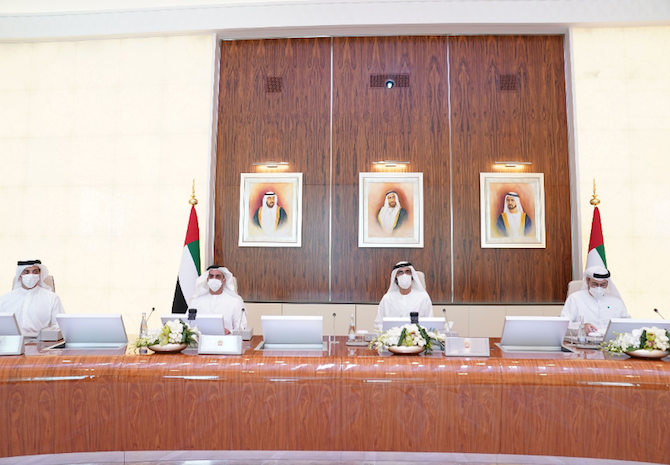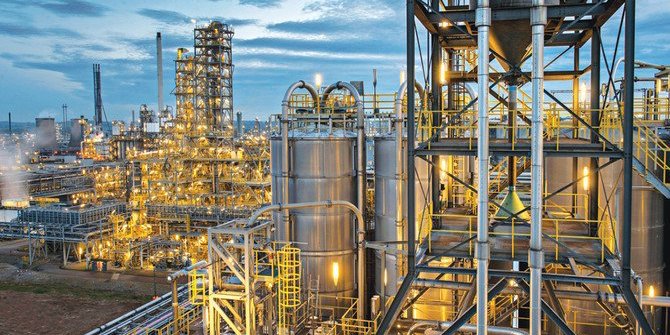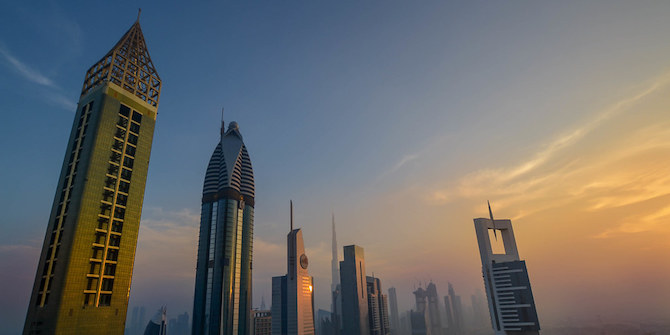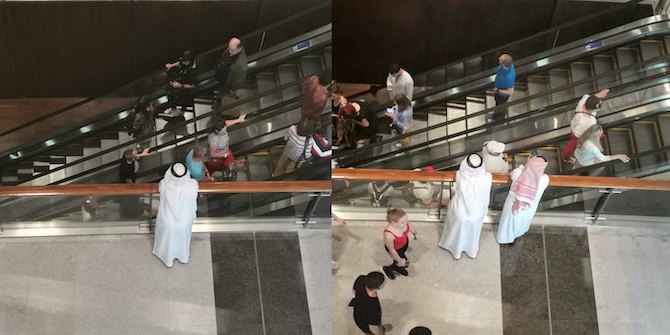by Saima Shadab

Chaired by Vice President and Prime Minister of the UAE and Ruler of Dubai His Highness Sheikh Mohammed bin Rashid Al Maktoum, the UAE Cabinet approved the National Agenda for Non-Oil Export Development in June 2021. Source: Government of Dubai Media Office
The dependency upon oil as the main source of economic growth in the oil-exporting Arab economies has been debated in the economics literature. Since the discovery of oil, the Gulf Cooperation Council countries (commonly known as GCC) are categorised as ‘rentier economies’ due to their heavy dependency upon oil as the main export commodity that serves as a crucial source of government income and economic growth. The economic model of GCC countries is often criticised because dependency upon a primary export commodity, particularly oil, renders the economic stability of these countries susceptible to oil price volatilities. Such natural resource-dependent economies suffer from deteriorating terms of trade that make their manufacturing sector less competitive. This has made diversification of these economies a pressing need. Presently, among the six GCC countries, the United Arab Emirates (UAE) is regarded as a successful model of economic diversification. Therefore, this study is an attempt to examine the short-run and long-run relationship between export diversification, economic growth, trade openness, physical and human capital in the UAE. The study highlights the importance of export diversification and trade openness for sustainable and stable economic growth in the UAE. For this purpose, the study employs various econometric tools. The study period in consideration is 1975–2017.
According to the empirical results, export diversification doesn’t cause the UAE’s economic growth in the short run. Therefore, the results indicate the UAE’s urgent need to diversify its exports by expanding the non-oil sector. Furthermore, a unidirectional causal relationship runs from trade openness to economic growth, implying that trade liberalisation encourages the UAE’s economic growth in the short run. A one-way causal relationship also exists from human capital to economic growth. This indicates that the UAE’s skilled workforce positively contributes to economic growth. A causal relationship runs from human capital to export diversification at a ten percent level of significance. This indicates that an increase in the level of skills and knowledge leads to an increase in non-oil exports and a decrease in the concentration of exports within the oil sector. This is because human capital that is skilled and productive results in the advancement of technology in the export sector, promoting export diversification in the UAE. Lastly, a unidirectional causal relationship also runs from physical capital to trade openness at a five percent level of significance, indicating that productive investments in the foreign trade sector open opportunities for trade liberalisation and promote openness to trade, which positively encourages the economic growth of the UAE.
The empirical results further reveal that a unidirectional causal relationship exists between export diversification and economic growth in the long run. This implies that export diversification promotes economic growth of the UAE through an increase in non-oil exports and a lower concentration of exports within the oil sector. Therefore, it can be stated that over the period 1975–2017, the UAE has successfully diversified its economic structure and attained a reduction in dependency on oil as the main export commodity. A unidirectional causal relationship runs from trade openness to economic growth and also from trade openness to human capital. This implies that trade liberalisation policies lead to an expansion of trade, resulting in improvements in productivity, technology and knowledge. This, in turn, improves the level of productivity and skills of the UAE’s human capital. A causal relationship exists from export diversification to human capital at all levels of significance.
Similarly, a causal relationship also runs from human capital to export diversification at all conventional levels of significance. In other words, a bidirectional causal relationship exists between export diversification and human capital in the UAE. This indicates the increase in non-oil exports and decrease in the concentration of exports within the oil sector led to advancement in technology, improvement in productivity, and increased skills and knowledge that encourage human capital in the UAE. This skilled and productive human capital, in turn, promotes export diversification in the UAE. A one-way causal relation is found running from physical capital to export diversification.
Similarly, a unidirectional causal relationship exists between physical capital and trade openness at a five percent significance level. This indicates that productive investments in the non-oil sector promote export diversification by decreasing exports within the oil sector and increasing the number of non-oil exports. Overall, the findings derived from this test confirm that export diversification promotes economic growth in the UAE. Therefore, the UAE government and its policymakers must continue to focus on building a strong and vibrant non-oil sector in order to prepare for the post-oil era.
This is part of a series on the possibilities and obstacles for economic growth, exports and diversification in the GCC states, based on contributions from participants in a closed LSE workshop in June 2021. Read the introduction here, and see other pieces below.
In this series:
- Exports, Diversification and Economic Growth by Kendall Livingston
- Economic Complexity and Exports: Kuwait in the Context of the GCC Region by Margarida Bandeira-Morais, Simona Iammarino and M. Adil Sait
- Growth in the Gulf: Four Ways Forward by Frederic Schneider
- The Role of Economic Complexity in Increasing Exports and Growth by Anis Khayati
- Beyond Oil: Have Manufactured Exports and Disaggregated Imports Contributed to Economic Growth in Kuwait? by Trevor Chamberlain and Athanasia Stylianou Kalaitzi
- The Nexus Between Export Diversification, Trade Openness and Economic Growth in the UAE by Saima Shadab
- Export-Led Growth in the UAE: Causality Between Non-Primary Exports and Economic Growth by Athanasia Kalaitzi, Samer Kherfi, Sahel Al-Rousan and Maria-Salini Katsaiti
- Reaching for the Stars: How and Why do the Gulf States Aim to Transform Their Economies to ‘Knowledge-Based Economies’? by Martin Hvidt







1 Comments